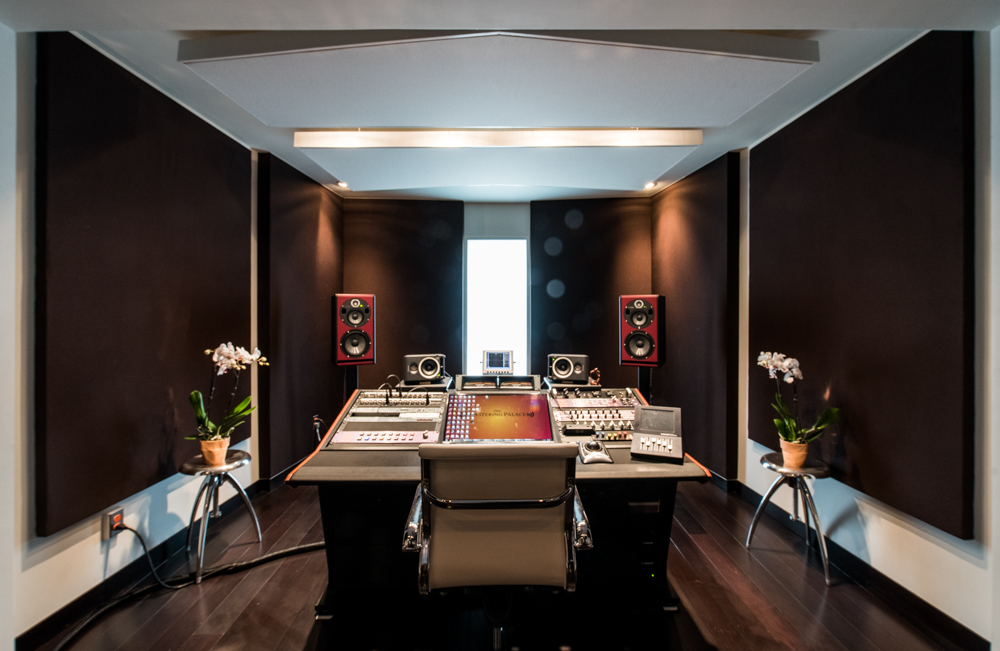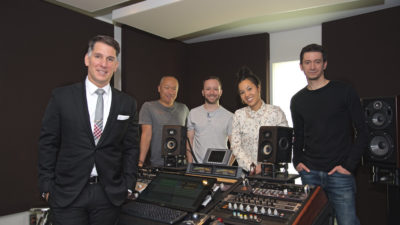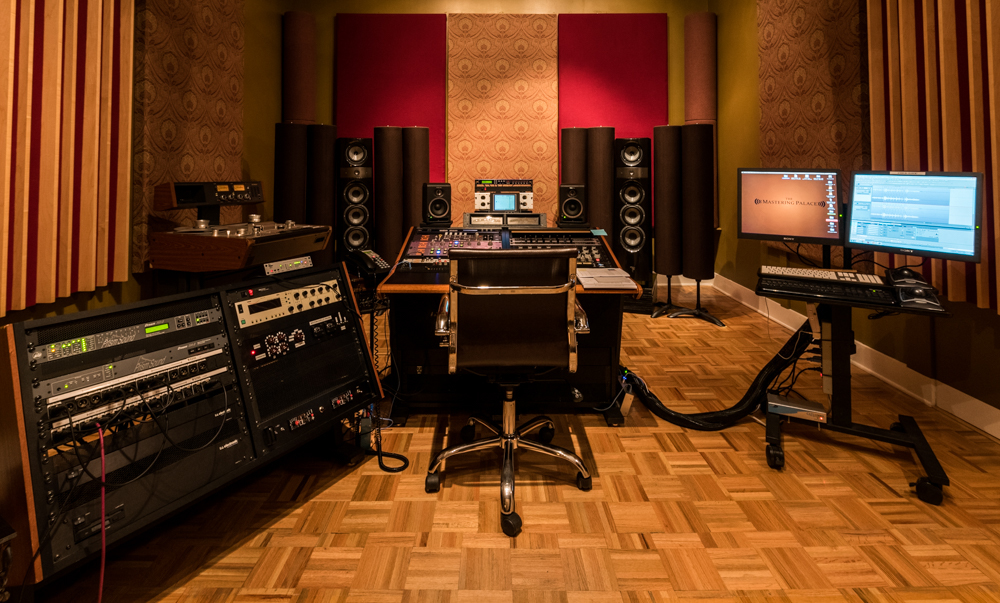Regal Hearing: Q&A with Dave Kutch of the Mastering Palace
The next time you’re on a stroll uptown, keep your eyes open for a firehouse on West 121st Street — then open up your ears. Put those senses together, and they’ll reveal something unexpected inside.
The first surprise is that this classic building transformed 10 years ago into The Mastering Palace, a prolific two-room facility spearheaded by six-time GRAMMY nominated engineer Dave Kutch. Then comes the second source of wonder, which is the ambitious music that arrives at your eardrums there – an array of original artists that are blazing trails in rap, pop, rock and genres that seem to elude description.
But that doesn’t mean Kutch’s clients are all far out on the indie fringe. Many of them are adventurous stars with a penchant for platinum including Beyoncé, Jill Scott, Miley Cyrus, Solange, Chance the Rapper, Justin Timberlake, Alicia Keys, Rae Sremmurd, Die Antwoord and Fifth Harmony. His colleagues at The Mastering Palace also sport clients who score big while taking chances, including Tatsayu Sato (A Tribe Called Quest, Danny Brown, A$AP Mob), and Mark Santangelo (Metallica, Slipknot).
How do you get to do what Kutch has done for a decade straight? Hanging up his own shingle came after years of hard work, graduating from an assistant engineer at Tiki Recording Studios and The Hit Factory, to mastering at Masterdisk and Sony Studios. His big break came courtesy of Alicia Keys’ engineer Ann Mincieli (founder/owner of Jungle City) and producer Kerry Brothers, who got Kutch onboard to master Keys’ 2007 As I Am in innovative fashion, working onsite at Keys’ Oven Studios on Long Island.
Turns out, not only had Kutch honed an expert touch for mastering at that time, but also a fierce independent streak that meant taking a big chance. Ten years later it appears that the risk of establishing The Mastering Palace has paid off — not just for Kutch, but for the risky artists that depend on his team to perfect their own musical dreams.
Dave, many of the projects that you’re working on are decidedly up-to-the-minute. What would you say makes the music that you’re mastering “modern”?
The more progressive artists are disregarding both radio and genre format, as well as traditional song structure. They’re doing something completely different — still maintaining melody, but changing the way songs are put together.
What do you think is allowing them to do that now?
I don’t think they were ever not allowed to do that before. But Chance the Rapper, the ASAP crew, the Odd Future crew, they’ve gotten bored of the norm and done their own thing. Obviously, it landed. They found an audience that wanted that thing: music that was new and different.
What are you hearing in the work of the next wave of artists, from a sonic standpoint?
It’s a combo – it ranges from great to not-great. They might have a talented mixing engineer, but maybe they didn’t have a great tracking engineer recording their vocals. Regardless of how good a mixing engineer may be, if you give them vocals that are recorded poorly and distorted, there’s not much you can do.
That’s a common thread: vocal quality has suffered. It’s a shame, because if someone is a strong vocalist, that’s the hardest thing to record. Often they’re recording on their own, and there’s things you can’t do at home.
How does your job change when you’re mastering for your platinum clients — elite artists like Beyoncé, Alicia Keys, John Legend?
These are people that have an engineer who’s with them the moment they want to create something from scratch. And not just any engineer, but someone who’s been with them for a while, who’s made a lot of records — someone with incredible skills and talent, who’s been with them since the original jump. That makes a big difference.
Your discography includes one of last year’s breakout hits, the GRAMMY-winning Chance the Rapper’s Coloring Book. What were your impressions when you first heard that mixtape?
It’s not what I was expecting! I had been a fan of Chance’s on all his features with other artists, but I had no idea the direction where his first album was going to go. It was awesome.
How would you characterize the experience you have when you hear something new and different?
It’s the “a ha!” moment. It takes you back to when you were a kid and the first time you heard Metallica, Guns & Roses, Rage Against the Machine, Nas. That moment excites me, not just as a mastering engineer, but as a music fan.
That’s why we’re all here. We all want to be rock stars, and we want to be involved in the creation of music. But when you hear something different that no one’s done before, that’s exciting.
Why do you think that this spread of projects, from late-breaking sounds to totally establishes stars, are finding their way to The Mastering Palace?
It’s what mastering has always been — they want that second opinion. They’ve been working on their album for months and months, and now they want someone with unbiased ears to go over it, give it what it needs, don’t give it what it doesn’t need, and polish their creation before it goes out to the world. Get that last hair perfectly in place. But that’s the same for artists working in traditional genres.
Mastering is also there to protect the artist’s work from the record company. We may not be able to give it to the record company just yet, until the artist says, “Yes, you can send it to the rest of the world.” I tell my staff all the time, “Mastering engineers are midwives between the artist and the record company.” They’re giving birth, and the record company wants what they’ve been paying for.
There’s a deadline, but the artist doesn’t care about that, they’ll give it up when it’s done. And the mastering engineer’s the person in between that, that final tug of war.
How A Mastering Studio Grows
How has The Mastering Palace evolved since you moved into your current home a decade ago?
It started with just me and one studio manager, and we got more and more work. That led to Tatsuya Sato joining as an additional engineer, and then the schedule kept getting busier and busier so I added another engineer, Mark Santangelo, as well as a second room designed by Martin Pilchner of Pilchner-Schoustal in 2014.
From there, as a business owner I tried to make workflows more efficient. I added a server, for example, so people can work from anywhere off the server instead of moving around additional drives.
We also just added something else, which is a Neumann VMS-70 lathe. I went through great lengths to get it — that’s a whole other story in itself. Mark was cutting vinyl at Sony, and I learned from Herb Powers, one of the greatest. The Neumann will be online very soon.
How have the mastering suites themselves changed over that time?
Just what you use, and how you use it. At the end of the day it’s about a good engineer in a good room with good monitoring. The toys in between are dashes of color that you like to add.
How did you settle on the Focal Solo 6 as your monitors?
Back in 2007 I had been on a search for a new nearfield, because they all sounded the same to me. Then Fab DuPont sent me a pair of Solo 6’s, right after Focal has started their professional line. They had everything I was looking for, that other manufacturers were failing in.
We developed a great relationship with the people of the company. Mastering is a service industry, and we take care of our clients’ needs very quickly. In turn, Focal has fielded some pretty crazy requests from me!
What advice would you give to a young mastering engineer who’s trying to determine if a speaker that they’re auditioning is right for them?
Nothing should hurt. You’ve got to trust the musician inside you. If you make an ugly face, then there’s probably something wrong and don’t think that it’s you — no, it’s the speaker. You should have an excited face when you listen to it. It’s the same with a song: If it doesn’t make me move, then I’m not there yet.
Dave, I noticed that you don’t want to drill in too deep about technical aspects of gear. Why is that a topic that you generally avoid?
We can go back and forth for hours on the clocks and all that. Gear is so good now, and there’s so much of it. Even the plugins are so good – the 64-bit world, we’re there.
I’ve never been a gear slut. I commonly find less is more. I add my dashes of color that I need, and nowadays there are so many dashes you can sit there and buy. You can buy 20 different plugins, six pieces of analog gear, and use any of those in different combinations and end up with the same result.
I’m not necessarily saying that too much gear gets in the way. It’s just never been about the gear. If I can find the sounds I’m hearing in my head, whether it’s from a plugin or a hardware piece, then I’ve got what I need.
For me, the most important gear is the speakers, and the converters too — the Dangerous Monitor ST and Focal speakers. Also VOVOX cabling. I hate talking about cable – I’m not a big gear guy, as you noticed – but it actually does make a difference. Bob Mueller from Dangerous Music told me what a difference he thinks it makes, and it does.
Developing Diverse Ears
Over the years, you demonstrated a proven track record across multiple genres — rock, rap, hip-hop, pop — what’s the key to achieving this diversity as a mastering engineer?
It’s just years. I’ve got my 10,000 hours+ times two. I also grew up with all forms of music in my home, listening to pop, soul, heavy metal — in New York City in the ‘80s, through the birth and rebirth of hip-hop, and I’ve always been paying attention.
You just have to be a huge music fan, have a huge catalog of music inside your head, and trust your ears. I rely on the music inside my head for every song I work on, referencing that catalog to say, “This song should sound like this. It was that instrument that made the song a hit.” Make sure that element shines.
The hardest part to learn is to trust your years. You have to do it and do it and do it. My advice to emerging engineers is: Any time someone will let you in a studio, be in that studio. Every engineer will tell you the same story, that when they were young, they would do anything they could to just be in a studio.
You’ve continued to increase your staff over the years. What are your personal criteria for the people who become engineers here?
The answer to that question goes back to why I built The Mastering Palace in the first place. I worked at some of the best mastering studios in New York — I didn’t like the way they were run. I didn’t like the way mastering engineers were pitted against each other. It didn’t create the greatest work environment.
But I’m not just gonna bitch about something. I’m going to put my money where my mouth is. I said, “I think you’re all wrong. I’m going to find out if I’m right.” So when I was building The Mastering Palace, I wanted a space that would be my happy place. I choose engineers first on their personality, and second on the genres that they work in. There’s always going to be a little bit of genre overlap among engineers, but if one guy is heavy in this category, and then another in that category, it works out great. No one is fighting over stuff.
And it’s worked out perfectly. This is still my happy place.
Mobile Lobes
Despite all the work that you’ve put into perfecting The Mastering Palace, you’re known for doing something that a lot of mastering engineers don’t do, which is setting up a temporary mastering suite and finishing an album there (see this article on Kutch’s work for Alicia Keys’ The Element of Freedom). Why do you like to go mobile sometimes?
I just did it for 2 ½ weeks in LA. I did Beyoncé’s Lemonade out there as well. I like a change of scenery, to come out of the box. The first time I did that was for Alicia Keys’ As I Am in 2007. Everything happened with that album: I used the Focals as nearfields for the first time, I discovered my enjoyment of working in another mastering room, The Mastering Palace was birthed.
Don’t get caught in a box. Don’t be routine. Change the gear up. You always have to evolve your own style, so here’s a challenge: Go in another room and make it work. I can do this anywhere — just give me certain pieces of equipment, a pair of Focals, and a day in the room to put up some TubeTraps. Those things are genius.
Cool Calculations & Harlem’s Harvest
When you struck out to find a home for The Mastering Palace in 2007, you found this ex-firehouse on a quiet block in Harlem. Was it the right move?
It worked out brilliantly. I’d like to say I was brilliant in the decision, but that’s not the case – it was simple math. I was opening my own business and paying for it out-of-pocket, and I had a certain amount. My gear was bought and paid for, and now I needed the math to work for me:
I had this chunk of money, and I needed to know that whatever the lease was for 18 months, I wouldn’t default. In 18 months. I would know if this would work or fail.
I looked at space downtown and the prices were crazy. An agent took me up to this space, it was the best one I saw, and it worked within the confines of my budget. I signed a lease, and I knew if I didn’t make a single dime and it was a total failure, that I could cover my lease and not default. Within the first six months, the company was in the black. Here we are 10 years later.
The neighborhood is great, and it’s seen drastic changes. There’s a tremendous amount of people from Midtown moving uptown, more and more restaurants, more and more stores, more and more luxury condos being built — just like every area of the city.
Lastly, how would you characterize the environment that you’re competing within now – how will mastering keep changing?
That’s a hard question to answer, because we’re going in opposite directions at the same time. We have streaming that is now increasing in sound quality, but on the other end vinyl sales are up year-over-year. There are clearly two desires being shown by the consumer: going back to the tangible of music, while going forward and having streaming sound better.
Mastering is just going to have to do what it’s always done, which is adjust itself per whatever the current format is, as decided by the consumer. We have to make it sound good in every environment possible. How we get there always changes, but that’s the end goal.
Equally important, mastering helps the artist achieve the final vision for their art — that will never change. That’s the prime directive. Yes, I quoted Star Trek.
- David Weiss
Please note: When you buy products through links on this page, we may earn an affiliate commission.











